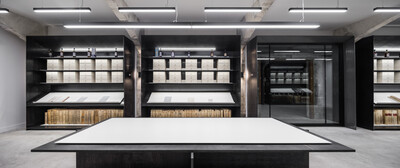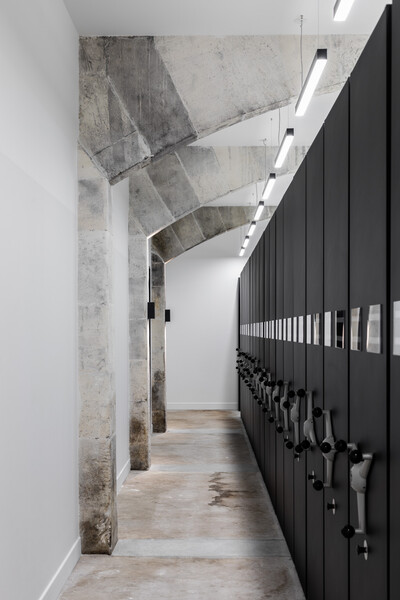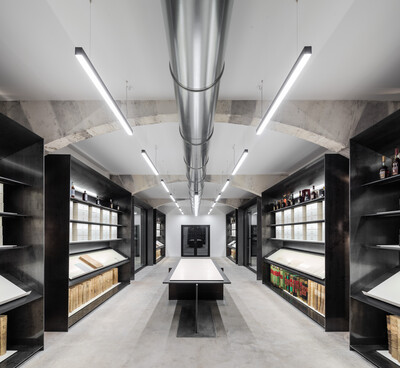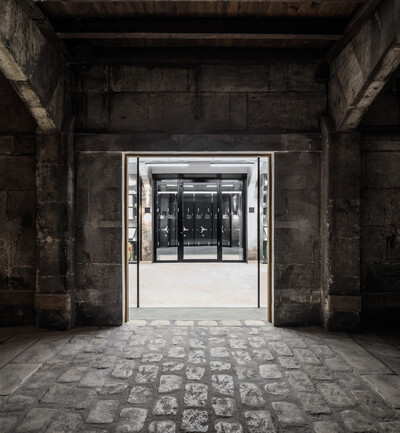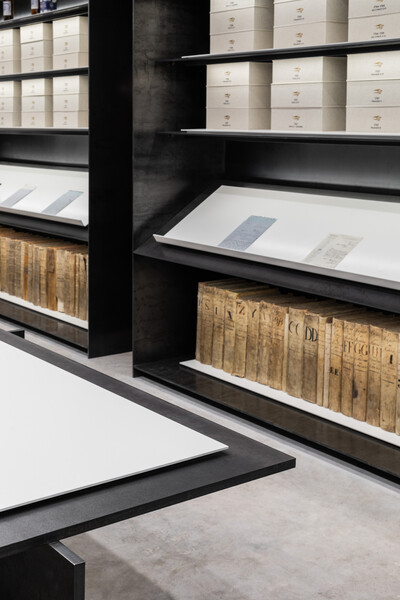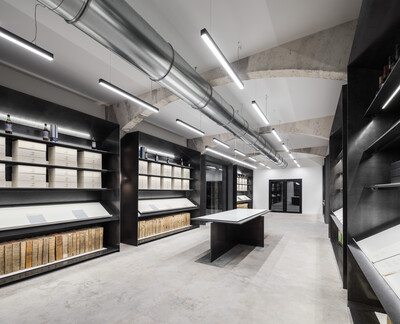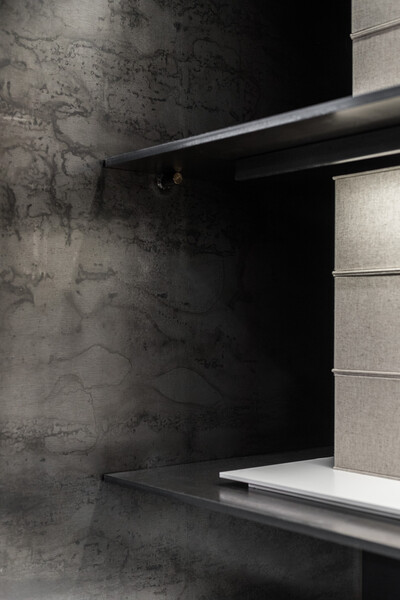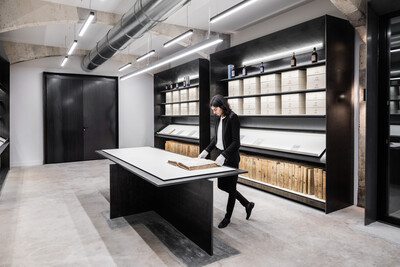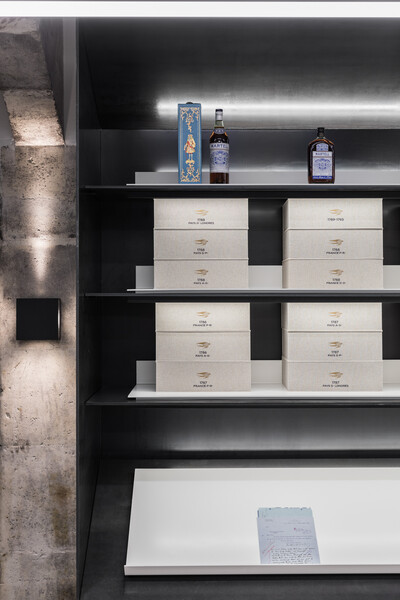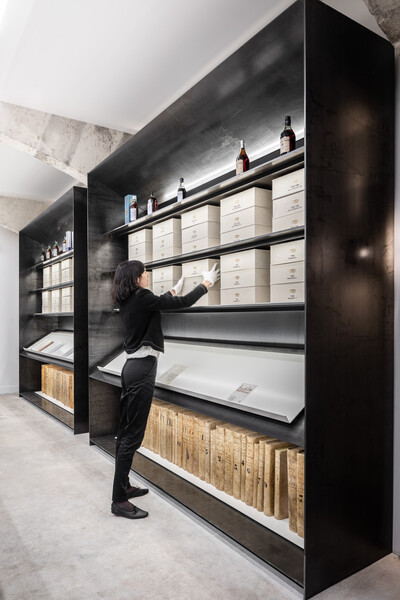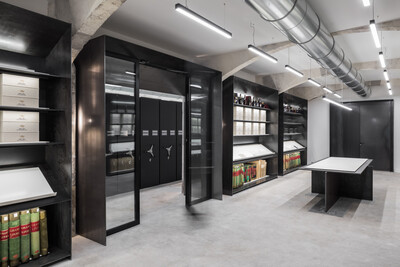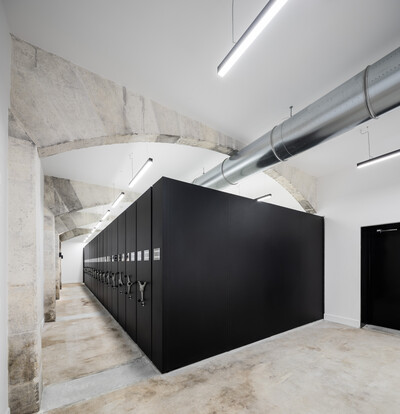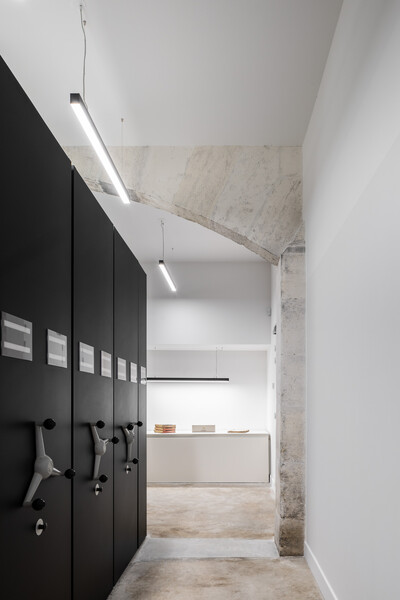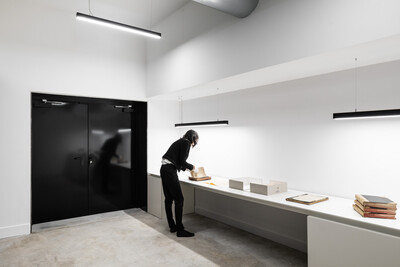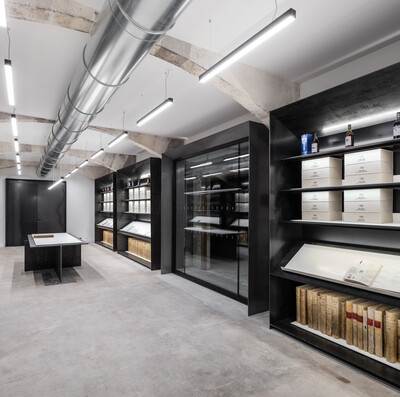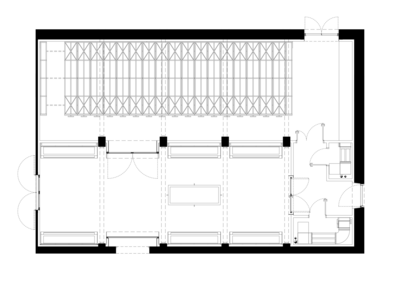After the chiaroscuro of the chais (spirits storehouses), the white lacquer of the archives plays on bold contrasts with the calamine of steel, the inox of the encasements, and the black of the shelves. Modernity is placed right up against the heritage elements.
Historical Archive
For the past three hundred years, Martell has conserved commercial registers, old books, bottles, and works of art. To showcase this legacy, two archival areas are installed within a former chai located along the discovery visit. Visitors are pleasantly surprised by the lighting activated by their presence, staged behind a window. They then access the display room, with its six bookshelves niched between stone vaults. At the centre, the archivist presents the precious documents on a long calamine-on-steel table, coated with white thermo-lacquered steel. This principle assumes a folded form on the steel shelves of the bookshelves: slightly detached shelf-covers protect the calamine from the handling of Cauchard boxes and leather compendiums. The curve of the underside of the bookshelves recalls that of the sandblasted vaults, reflecting the light right down to the exposed concrete floor. In the background, the conservation area is inaccessible, keeping the contents of its mobile shelves a mystery. The stark white lighting is even more distinctive. The technical details are cleverly concealed. The air from the extraction unit on the ceiling is sucked through the double-framed door of the machine room and the structural supports in the basement (each bookshelf weighs 2.5 tonnes) remain invisible. Collaboration after collaboration, a vocabulary and its spatial codes variously unfold to strengthen the architectural identity of the brand.
171 rue du Tondu 33 000 Bordeaux — France
09 81 24 04 40
Stanislas Elluin
Architect DEHMONP, partner
stanislas.elluin@edgar.archi
Igor Duolé
Architect DEHMONP, Civil Engineer ESTP, partner
igor.duole@edgar.archi
Ludovic Esnault Gillon
Architect DE, partner
ludovic.gillon@edgar.archi
Caroline Chabot
Architect DE
caroline.chabot@edgar.archi
Emeric Le Bos
Architect DE
emeric.lebos@edgar.archi
Vincent Saura
Architect DEHMONP
vincent.saura@edgar.archi
Design: Spassky Fischer and Antoine Elsensohn
Photography: Ivan Mathie
Texts: Fanny Léglise
Development: Tristan Bagot
Edgar sees contemporary architecture as a way of generously exploring both spatial and social potential. Each project represents a chance to question and test various possibilities so as to spark a conversation with the customer. Edgar pays particular attention to the historical and landscaping context that each situation presents. Each experience requires flexibility in terms of process on the part of its designers and their solutions. Oscillating between devising a home extension on a shoestring and an extraordinary commission requires major adjustments, in which the eclecticism of architectural composition becomes clear. Edgar seeks a sensitive sobriety that stems from the enhancement of structure. The constructive aspect is expressed through grid compositions that organise the space. The architecture is explicit, avoiding overstatement. The finishings are discreet, with the accent placed on constructive efficacy.
The structure forms the architecture,
the material defines the project,
and story is its guide.
The Edgar office is on a street corner, engaging local practice, and handy to its partners. Added to the complementary abilities of its founders (engineering, architecture, scenography, and architectural culture communication) were the singular profiles of a rapidly expanded team. Given how scales and fields of intervention are freely invested, the duos established to manage each project are mixed and matched. The power of collective work guarantees an open-minded vision of the profession, where the agency takes the time to discuss architecture and show its work, particularly behind-the-scenes views of its construction sites.
Born in 2017, Edgar is an alter ego, the acronym of its three founders, graduates from the École Nationale Supérieure d’Architecture et de Paysage de Bordeaux. The agency was created through Stanislas Elluin’s, Igor Duolé’s, and Ludovic Gillon’s shared ideas about architecture. The complementary backgrounds of its founders make up “the album” of Edgar, based on a common analysis of cultures of habitation and design of urban systems, relating architecture to its historical period and composition to its significations.
After the chiaroscuro of the chais (spirits storehouses), the white lacquer of the archives plays on bold contrasts with the calamine of steel, the inox of the encasements, and the black of the shelves. Modernity is placed right up against the heritage elements.
Historical Archive
For the past three hundred years, Martell has conserved commercial registers, old books, bottles, and works of art. To showcase this legacy, two archival areas are installed within a former chai located along the discovery visit. Visitors are pleasantly surprised by the lighting activated by their presence, staged behind a window. They then access the display room, with its six bookshelves niched between stone vaults. At the centre, the archivist presents the precious documents on a long calamine-on-steel table, coated with white thermo-lacquered steel. This principle assumes a folded form on the steel shelves of the bookshelves: slightly detached shelf-covers protect the calamine from the handling of Cauchard boxes and leather compendiums. The curve of the underside of the bookshelves recalls that of the sandblasted vaults, reflecting the light right down to the exposed concrete floor. In the background, the conservation area is inaccessible, keeping the contents of its mobile shelves a mystery. The stark white lighting is even more distinctive. The technical details are cleverly concealed. The air from the extraction unit on the ceiling is sucked through the double-framed door of the machine room and the structural supports in the basement (each bookshelf weighs 2.5 tonnes) remain invisible. Collaboration after collaboration, a vocabulary and its spatial codes variously unfold to strengthen the architectural identity of the brand.
